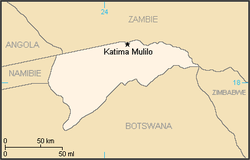This article needs additional citations for verification .(August 2014) |
East Caprivi Oos-Caprivi Ostcaprivi | |||||||||
|---|---|---|---|---|---|---|---|---|---|
| 1972–1989 | |||||||||
Coat of arms [2] | |||||||||
 Allocation of land to Bantustans according to the Odendaal Plan. East Caprivi is in the top right corner. | |||||||||
 Map of the Bantustan | |||||||||
| Status | Bantustan (1972–1980) Second-tier authority (1980–1989) | ||||||||
| Capital | Katima Mulilo | ||||||||
| Common languages | Subiya English Afrikaans | ||||||||
| History | |||||||||
• Self-government | 1972 | ||||||||
• Re-integrated into Namibia | May 1989 | ||||||||
| Currency | South African rand | ||||||||
| |||||||||
East Caprivi or Itenge was a Bantustan and later a non-geographic ethnic-based second-tier authority, the Representative Authority of the Caprivis in South West Africa (present-day Namibia), intended by the apartheid government to be a self-governing homeland for the Masubiya people.

